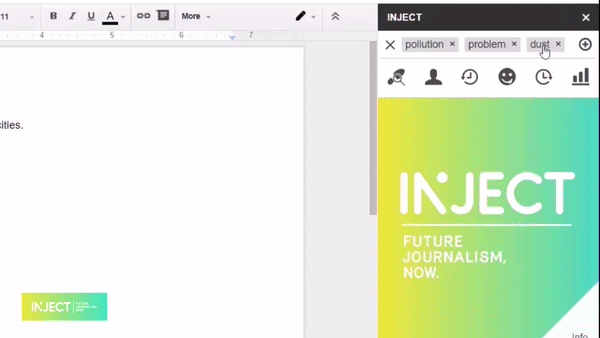INJECT: a journalism and technology project building creativity tools for journalists
The INJECT project unites 14 partners in 6 European countries in the development of new digital technologies for news organisations. The goal is to improve the creativity and productivity of journalists in a digital world, so they can continue to perform their crucial role in open societies.
INJECT, Innovative Journalism: Enhanced Creativity Tools, is a European project uniting 14 partners in 6 countries, including the Global Alliance for Media Innovation. This project has received funding from the European Union’s Horizon 2020 research and innovation programme. INJECT’s objective is to transfer new digital technologies to news organisations to improve the creativity and productivity of journalists, in order to increase the competitiveness of European news and media organisations.
The INJECT project builds on results from the 2016 Google-funded JUICE project at City, University of London, as a collaboration between the Centre for Creativity in Professional Practice at the Cass Business School and the Journalism Department. Broader research into new tools for journalists won an EU Horizon 2020 grant of just under €1m, and the INJECT project started its work in January 2017.
Professor of Digital Creativity at City, University of London Neil Maiden is leading this industry-academic collaboration and believes INJECT “is the first tool that seeks to integrate productivity and creativity support directly into the digital work of journalists. It builds on successes in other domains to deliver key innovations in journalism.”
Creativity support tools
The idea is not to make journalists more creative, as it is acknowledged that journalism is a creative profession. However, journalists need enough time and resources in order to be creative. As journalists are under increased pressure to produce stories for a 24/7 news cycle and discussions about churnalism, filter bubbles and fake news raise questions about the possibility to do so, finding ways to continue producing original and quality stories is more urgent than ever. Neil Maiden explains:
“What INJECT will do is to make journalists as creative as they are at the moment, but more efficiently. The INJECT tool will do this by implementing strategies that will enable them to undertake some of the work of experienced journalists more quickly, to permit and support journalists to spend more time on creative thinking and story development.”
The tool includes a creative search engine that reporters can use to search relevant information sources for new angles, and to investigate further and deeper into the background of the stories they are working on, as well as a functionality that brings articles to life with interactive fact cards.
The tool is also designed to integrate seamlessly with the tools that journalists already use, as simple sidebars and add-ons to Google Docs, WordPress and targeted content management systems. Journalists do not need to change how they work, to use INJECT.
Innovating together
INJECT is a collaborative innovation project joining journalists, academics, research centres, developers, media organisations and business organisations. By integrating journalists’ feedback directly into the developing process, INJECT aims to build creativity tools that are helpful and easy to use in the newsroom.
To this end, consortium members of the University of Bergen, M’Labs, Explaain and City, University of London visited the local newspapers Sunnhordland and Hordaland in Norway this spring to discuss possibilities for the local implementation of the INJECT tool. The editor in chief at Sunnhordland, Magne Kydland, showed the team how the newspaper is run. The consortium participated in the daily editorial meeting, talked to editorial and technical staff, and presented INJECT in a plenary session.
Initially, the tool will be further developed in collaboration with the local Norwegian newspapers. Later, a similar endeavour will be launched in collaboration with the Dutch journalism partners in the consortium, freelancer networks VersPers and VJ Movement. The idea is to develop different versions of the tool for different journalism markets across Europe.
INJECT: Technology meets journalism
Exploring the ways in which technology can support journalists’ work, INJECT uses creativity techniques based on Natural Language Processing (NLP). Specifically, it is adapting digital search to mimic how experienced journalists work creatively, to discover new angles on stories. More specialised search can support journalists to discover new information and story angles, to do this more quickly than at present, and to generate the resulting stories more productively.
“There are clearly some outcomes of computer science research that exceed current human abilities. One of these is search. Digitalisation enables the effective search of large volumes of information much more quickly and accurately than people can. Search is important in journalism, to discover data, the back story, human angles and the underpinning causes – the long read.”
INJECT also scans texts for keywords and automatically links them to additional information. In order to make it easy for journalists to integrate the toolkit into their work practices, the software will be built directly into content management systems.
According to Professor of Journalism George Brock (City, University of London) “INJECT aims to do something which no other software for journalism attempts: to combine creative search techniques and ways of telling the reader more about background and sources. And this help is easy to use and fast.”
CONTACT POINT

Neil Maiden, Project Coordinator INJECT, City, University of London
Web: http://injectproject.eu/
Twitter: @NeilMaiden

